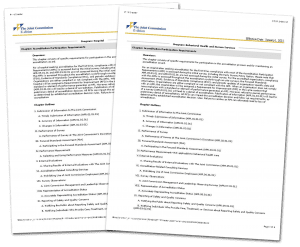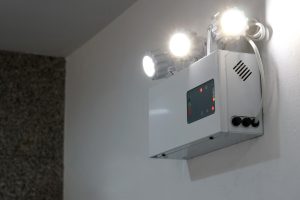August 2021
Inside This Issue
Hopefully everyone is enjoying their summer, and perhaps got some time off for a little R+R. We have reviewed the August publications from TJC and CMS and as is typical, August is a slow month. There are no new requirements discussed, or short deadlines to take action, but there are several thought provoking articles that you will want to take a look at.
Patient Visitation Policies:
The lead article in Perspectives discusses a new publication from the Planetree International and the American Nurses Foundation on patient visitation policies in healthcare organizations. During the peak of the Covid epidemic many organizations had significantly limited or eliminated visitation by family members. This article points out the contribution to patient safety that family members or loved ones can play by advocating, observing, identifying small changes in patient status, helping with instructions and patient education.
They also point out that the absence of family members and loved ones can pose a safety risk. There is a link in the article to a document Planetree International developed, which is duplicated here.
This document looks particularly helpful in guiding visitation decision making using a risk assessment methodology. With concerns in the media at this time about new spikes in Covid infections, this publication may be helpful to your continued policy development around visitation.
Insulin Pumps and Continuous Glucose Monitoring Devices:
 Perspectives also has an article referencing an issue of the Joint Commission publication entitled Quick Safety #59 which discusses insulin pumps and continuous glucose monitoring devices.
Perspectives also has an article referencing an issue of the Joint Commission publication entitled Quick Safety #59 which discusses insulin pumps and continuous glucose monitoring devices.
We had an extensive discussion on this same subject in our June Newsletter so we won’t belabor the subject again. However, it is important to remember that surveyors read many of the same publications you do, so with the Quick Safety and the June Perspectives article on this same subject, it is more likely to be on surveyors’ minds than it might have been in the past. If you have not already analyzed and refined your policies on such devices you will want to get this underway soon, as it is probably going to be on the radar screen for surveyors.
HAP or BHC Manual?
 Perspectives has an article explaining the relationship of hospital accreditation and behavioral health accreditation in complex organizations providing both services, what TJC considers their “tailored survey process.” Due to CMS and deemed status requirements, most hospital-based behavioral health services have always been reviewed using the hospital manual, while relatively few, highly specialized behavioral health services were reviewed using the behavioral health manual.
Perspectives has an article explaining the relationship of hospital accreditation and behavioral health accreditation in complex organizations providing both services, what TJC considers their “tailored survey process.” Due to CMS and deemed status requirements, most hospital-based behavioral health services have always been reviewed using the hospital manual, while relatively few, highly specialized behavioral health services were reviewed using the behavioral health manual.
For example, day treatment and partial hospitalization programs above a certain average daily census have been reviewed using the CAMBHC. This article places a different spin on the process than we have previously heard, in that TJC states that all (deemed) hospital-based behavioral health services are reviewed using the hospital manual and a small subset such as larger partial hospital or day treatment will also be reviewed using the CAMBHC. We presume this nuance is a stipulation to satisfy CMS.
The article does mention a larger number of unique behavioral health programs that might be tailored with the CAMBHC such as group home, foster care, and residential programs, but few acute care hospitals have such programs. Psychiatric hospitals surveyed using the CAMH may have more of these and should review the list carefully to help guide planning which services might be subject to the additional focus using the CAMBHC.
Emergency Power Systems:
 This month’s Consistent Interpretation column discusses 3 of the 10 elements of performance relative to emergency power systems under EC.02.05.07. The noncompliance rates for these 3 elements of performance were not huge in 2020, with the highest being EP 2 just over 7%, but we do frequently see documentation quality issues with these elements, and less often just a failure to conduct the test or the ability to find the test report.
This month’s Consistent Interpretation column discusses 3 of the 10 elements of performance relative to emergency power systems under EC.02.05.07. The noncompliance rates for these 3 elements of performance were not huge in 2020, with the highest being EP 2 just over 7%, but we do frequently see documentation quality issues with these elements, and less often just a failure to conduct the test or the ability to find the test report.
You will want to share this article with your team responsible for documenting emergency lighting and generator testing. The EP text and the Guidance/Interpretation advice from TJC are the important sections to examine in this article. Some issues you might want to validate include:
- Are the battery-operated egress lights and exit signs tested for 1.5 hours at least once each year?
- In areas of new construction, renovation or modernization are the battery-operated lights in areas where deep sedation and general anesthesia are performed tested at least once each year for 30 minutes?
- Does your documentation of monthly generator testing include the start and stop times of the generator under load for a minimum of 30 minutes?
- Does your documentation of monthly generator testing indicate that the test was performed under load for 30 minutes and the off load, cool down period was after completion of that 30 minutes?
- If your generator test is unable to meet the 30% load requirement, is there documentation that the exhaust gas temperature met the manufacturers recommendation?
- If your monthly generator test is unable to meet the 30% load requirement, is there documentation of an annual 90-minute test that includes meeting a 50% load for 30 minutes and a 75% load for 60 minutes?
Requirements in Development:
 The last thing from Perspectives we wanted to draw your attention to is towards the end of each month’s issue and that is the “In Sight” column with topics currently being considered for standards modifications. We noted that changes are being considered for antibiotic stewardship standards and emergency management standards.
The last thing from Perspectives we wanted to draw your attention to is towards the end of each month’s issue and that is the “In Sight” column with topics currently being considered for standards modifications. We noted that changes are being considered for antibiotic stewardship standards and emergency management standards.
If TJC’s advisory committees and Board support further development of these topics you should see a web posting for comment sometime in the coming year. This is an important opportunity to see what might be coming, and an opportunity to help shape the process through providing feedback about the draft standards to TJC. Be on the lookout for that posting as they often have a short timeframe for comment.
Family Reunification:
 The lead article in this month’s EC News is about family reunification planning during or after a disaster. The article points out that TJC recommends, but does not mandate such a plan today, but as we just mentioned modifications to the EM chapter are being discussed right now.
The lead article in this month’s EC News is about family reunification planning during or after a disaster. The article points out that TJC recommends, but does not mandate such a plan today, but as we just mentioned modifications to the EM chapter are being discussed right now.
Given the impact of fires and floods on the healthcare industry in the past few years, this certainly sounds like a worthwhile addition to EM planning. The author highlights the impact of a surge of patients during a disaster and the corresponding influx of family members and media in addition to the patient surge. These family members will be looking for information about loved ones and media will be looking for newsworthy sound bites, so having well planned and accurate information is essential.
They also advise space planning for what they call a family reunification center, separate from the media center and those who are just curious. They even suggest a registration and vetting process for family members confirming their relationship to the person they are inquiring about. As some patients may arrive at the emergency department without identification they suggest inquiry during the vetting about piercings, birthmarks and tattoos that might help in identification of patients.
You will want to share this article with your emergency planning team for assessment of your current readiness and/or discussion about how well your current plan worked during the last disaster or drill. If you have not formally tested this scenario you might want to consider an “influx” of family members and media for the next drill.
New Water Management Standards:
 TJC and this newsletter have previously discussed the content of the new water management standards that will take effect in January 2022. This month’s EC News indicates that TJC will be evaluating and educating on the new requirements, but not formally scoring RFIs during surveys conducted between July and December 2021.
TJC and this newsletter have previously discussed the content of the new water management standards that will take effect in January 2022. This month’s EC News indicates that TJC will be evaluating and educating on the new requirements, but not formally scoring RFIs during surveys conducted between July and December 2021.
This has the potential to be helpful, but as we advised in our April newsletter and TJC reminds readers of EC News, these standards are already potentially scoreable due to the generic EC.02.05.01, EP 14 which already requires an organization to minimize pathogenic biologic agents in water systems.
For several years TJC has been advising use of the CDC and ASHRAE guidance documents on water management. Regardless of your survey window, this article is a useful reminder of the water management requirements and safety strategies that will definitely be scored come January and potentially could be scored sooner if it does not appear you took actions to “minimize” risk from water systems.
The EC News article also lists the prior EC News articles you might want to re-review going back to 2017 on water safety strategies and again provides links to the CDC Toolkit and the ASHRAE documents. As a reminder the CDC documents are free, the ASHRAE documents are available for purchase.
Planning for Construction:
 The August edition of EC News has an article that focuses on design and infection control hazards that should be required reading if you have any construction or remodeling plans coming up. A lack of functionality or efficiency is something we often see and hear off-handed comments from staff such as “no one asked us” about the plans.
The August edition of EC News has an article that focuses on design and infection control hazards that should be required reading if you have any construction or remodeling plans coming up. A lack of functionality or efficiency is something we often see and hear off-handed comments from staff such as “no one asked us” about the plans.
This article zeroes in on infection control issues that should be considered when designing new or renovated space. The authors provide ten suggestions for planning that should be considered in every project. These are:
- Designers should go with healthcare staff on environmental rounds to see how they work and what their priorities and issues are with the workspace.
- Designers should be familiar with standard infection prevention precautions such as airborne, blood born, hand hygiene, donning and doffing of required attire.
- Read the latest research on the environments impact on behavior and infection risks.
- Hand hygiene sinks should be readily available so staff can utilize them efficiently.
- Sink design should prevent dispersal and a bowl depth of less than 19 centimeters leads to more potential contamination.
- Look at the adjacencies such as toilets to counter tops as they advise that toilet flushing can lead to dispersal. More specifically they mention that C diff spores are reported to remain in the toilet bowl even after 24 flushes.
- Install room pressure monitors with alarms. We see this on consults and on Joint Commission reports all the time, where a negative or positive pressure sensitive area does not have a pressure monitor and alarm and when tested it is identified the pressure is not correct.
- Floors can be part of the chain of infection. They warn that floors can harbor some very problematic pathogens including C diff, MRSA and VRE. Improper cleaning of objects that have been in contact with the floor can then spread these pathogens to the patient.
- Separate soiled from clean activities and spaces, and make it easy to be compliant. Although there is no specific standard that states this commonsense requirement, this is a very common surveyor observation technique. It is very common for surveyors to look for separation of clean and dirty activities during environmental rounding and it is unfortunate how often issues arise with this subject. Things that we sometimes observe comingled make the staff escorting us cringe, but in a rush, people sometimes put things down where they don’t belong.
- Attractive furnishings should also be clean-able. They specifically talk about bare wood and chemo contaminants, but the same problem would arise relative to pathogens that can’t easily be cleaned off bare wood. We would also warn readers about once functional fixtures that get gouged or Formica is peeling thus exposing bare wood that can’t be cleaned.
This article looks like a keeper that should be saved if you don’t have renovation plans right now, for the time when you do start a construction project. It is an important reminder of things to consider.
Electrical Hazards in Health Care:
 The last article in EC News suggests and electrical safety program to help protect patients and staff from electrical shock, arc flash, explosions, and fire. It is highly technical but should be shared with the facilities leadership responsible for electrical safety or utilities management.
The last article in EC News suggests and electrical safety program to help protect patients and staff from electrical shock, arc flash, explosions, and fire. It is highly technical but should be shared with the facilities leadership responsible for electrical safety or utilities management.
There is an excellent discussion of the hazards and then two clear suggestions for risk control methods similar to what you have previously seen for hazardous drugs or other hazards where elimination of the hazard is the most effective method of controlling risk.
There is also advice on controlling energized electrical work in your buildings and an Electrical Safety Program Checklist you can use to self-evaluate your electrical safety program with content questions which can be assessed yes or no, along with comments. Our advice as always with helpful checklists like this is to add one step called “show me.”
When it says you have a policy and it addresses a specific issue, show me the policy and the section that addresses this issue. Similarly, when it says documentation is maintained, “show me” the documentation that this was done. It is too easy for the person conducting the self-assessment to think, “yes, that is my/our process,” but if it isn’t codified in a policy or documented, that assumption may not be universal.
COVID-19 Data:
 CMS did not post any new QSO memos this month. The last four months we provided the link to the data CMS is analyzing relative to Covid-19 test positivity in counties throughout the US. We thought we might discontinue reporting on that this month, but then the CDC changed its mask guidance for members of the public, we thought we might examine the data one more time.
CMS did not post any new QSO memos this month. The last four months we provided the link to the data CMS is analyzing relative to Covid-19 test positivity in counties throughout the US. We thought we might discontinue reporting on that this month, but then the CDC changed its mask guidance for members of the public, we thought we might examine the data one more time.
Unfortunately, that link no longer takes you to the state test positivity data, the link has now has been re-used to take you to nursing home data and we have not been able to locate that same data on the CMS site. We did find similar, but much more extensive data on the CDC website that you might want to explore.
This is sorted by state and county and you have to search for your specific state report and the county data will be in that report. We looked at one state report and it was 17 pages with much more information than just test positivity. That data can be found using the following link.
Consultant Corner
Dear Readers,
We know we mentioned that we would be skipping a Patton Post in August,
but we couldn’t wait for September to bring more important information to you.
We hope everyone is enjoying their summer! See you next month!
Have a wonderful rest of your summer!
Jennifer Cowel, RN MHSA
JenCowel@PattonHC.com
Kurt Patton, MS RPh
Kurt@PattonHC.com
John Rosing, MHA
JohnRosing@PattonHC.com
Mary Cesare-Murphy, PhD
MCM@PattonHC.com
